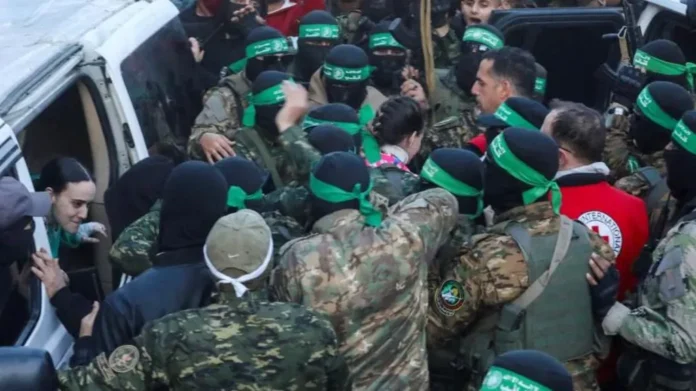Inside the operation to bring Israel’s hostages home from Gaza
Reuters Doron Steinbrecher walks through a crowd of Hamas fighters, with their faces covered and wearing green bandanas, and Emily Damari gets out of a vehicle as both women are handed over to the Red CrossReuters
Hamas handed over Emily Damari and Doron Steinbrecher earlier this month
It begins with a phone call with a location.
Once the details are received, a team from the International Committee of the Red Cross (ICRC) sets off in vehicles marked with the humanitarian organisation’s logo to pick up the hostages in Gaza.
Israeli military and medical personnel are also assembled at several different locations, waiting to bring them home.
The hostage releases, watched around the world, come after months of tense negotiations aimed at ending a war that began on 7 October 2023, when Hamas fighters killed some 1,200 people in Israel and kidnapped 251 others.
In the 15 months that followed, more than 47,000 Palestinians were killed in Gaza, according to the Hamas-run health ministry, and many more lost their homes in Israeli bombardments.
Under the terms of the ceasefire deal between Israel and Hamas that began on 19 January, a total of 33 Israeli hostages are due to be released and returned to their families during the first phase, lasting six weeks.
In exchange, hundreds of Palestinian prisoners in Israeli jails are being freed.
If anything goes wrong, it risks the hostages remaining in captivity, and reigniting the war.
“This is more than just a drive,” says ICRC spokesperson Sarah Davies.
“These operations may seem simple, but in fact they are very complex and require rigorous security measures to minimise the risks to those involved.”
The ICRC, which acts as a neutral intermediary in the handover, assembles a team of specialists, some of whom have been involved in similar operations in the past – though this is more challenging than most.
Crucial planning
There are some details that the group cannot speak about publicly because of concerns that it could compromise the security of the operation.
Ms Davies says planning is crucial to ensuring that the exchange runs smoothly. They have mapped out alternative routes to get to different locations in Gaza, knowing that the “safest route can change” at any time.
Among their biggest concerns are the dangers posed by unexploded ordnance, destroyed and damaged infrastructure, and large crowds with “heightened emotions”.
“Our teams prepare and plan for as many scenarios as possible,” she says.
“The most important thing for us is to be able to return any person entrusted to our care safely back to their homes.”
But it is impossible to plan for everything.
“From previous experience, here and in other places around the world, we know that the logistics and final details can change at any time, even – and particularly – during operations themselves,” says Ms Davies.
Medical staff and so-called weapons contamination specialists, trained in identifying explosive remnants of war, travel with the teams.
During the operations, ICRC representatives also maintain regular contact with both Israeli officials and Hamas, as well as mediators.
Getty Images A Red Cross vehicle is surrounded by a crowd of people including photographers and Hamas fightersGetty Images
A crowd gathered in Gaza City for the release of three Israeli hostages on 19 January
In the previous releases, Hamas has circulated the names of the released hostages in advance on its Telegram channels, without revealing exactly where the handovers will happen.
The first public signs of the locations have been the presence of armed and masked members of Hamas’s military wing.
“I found out from a kiosk guy that there was something happening at the junction and that al-Qassam fighters were having a parade,” a local journalist says of the first release in Gaza City earlier this month.
Crowds started gathering to watch as the fighters assembled in formation, and word began to spread that the first three hostages released under the ceasefire deal would appear there.
“When people realised this would be the place where they would hand over the Israeli hostages, people started chanting [for al-Qassam and senior Hamas figures],” he says. “They started shouting ‘God is greatest’ – that showed how joyful they were.”
The journalist was also there for the second release – at a different location in Gaza City – the following week, which he describes as being “more organised”.
The fighters set up a small stage area with a desk and chairs, and stood in formation to separate the hostages from the crowds.
White cars with blacked out windows were used to bring the hostages – four women soldiers – to the area.
The young women were filmed thanking their captors and being handed gift bags in a video published by Hamas’ military wing.
They were brought on to the stage and waved at the cheering crowd, before being handed over to the care of the ICRC.















